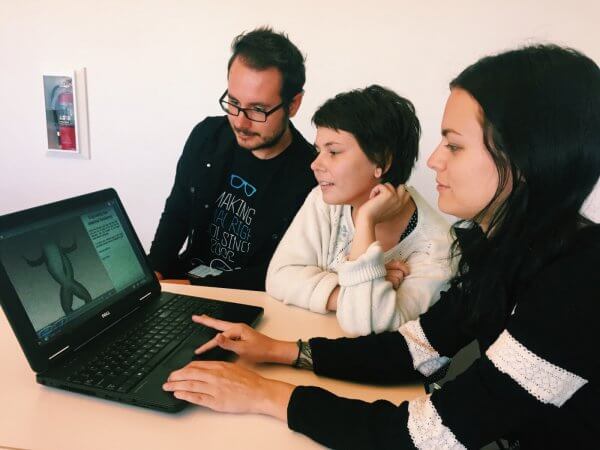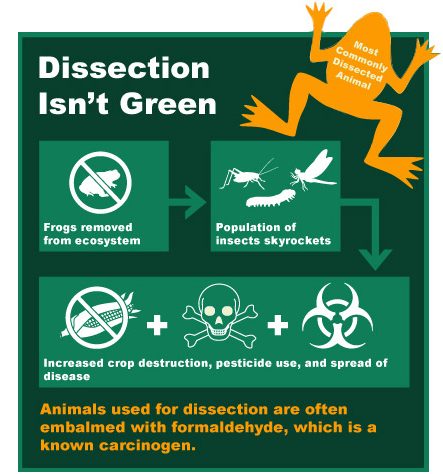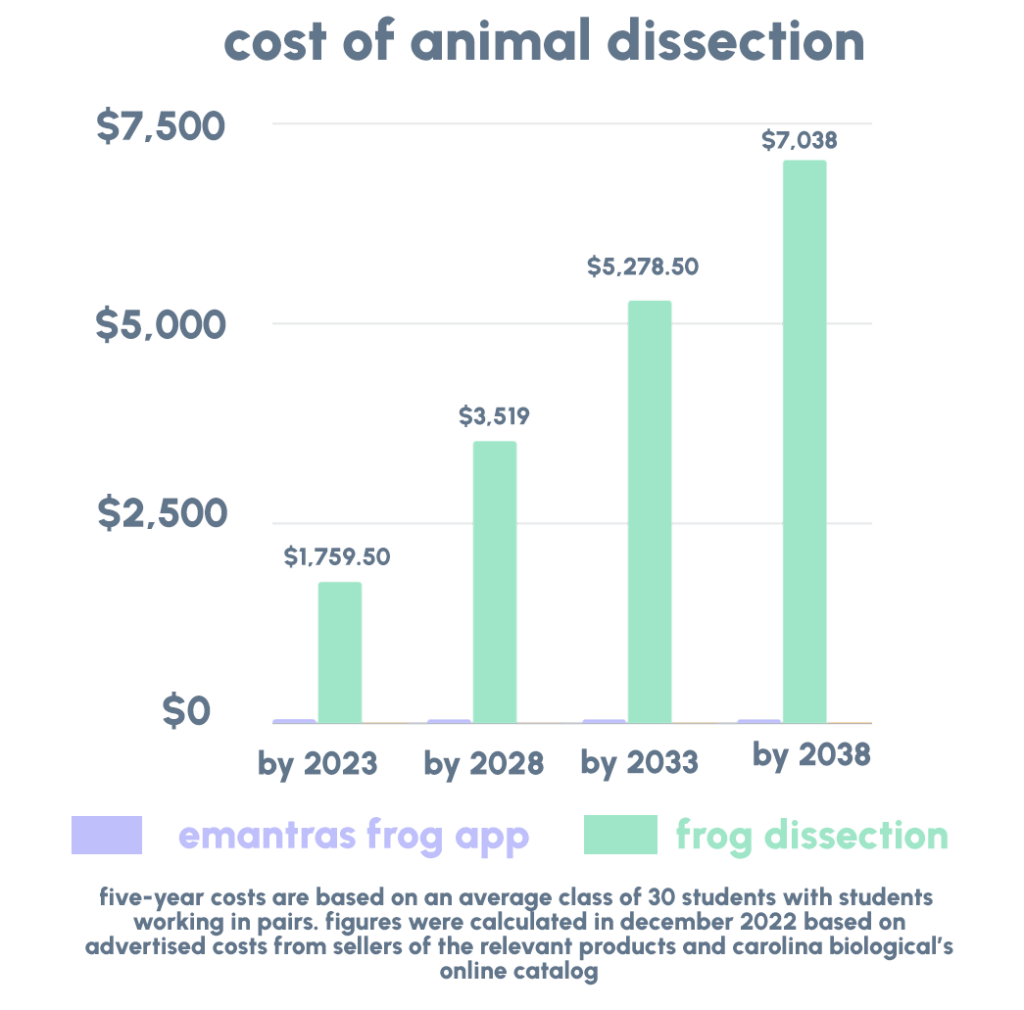Cut Dissection Out of Your Curriculum
By providing your school with humane alternatives to dissection, you’ll be sparing thousands of animals a life of misery. As more students speak out against dissection, more administrators will see the importance of using superior interactive technology in their schools.
Many states have laws and policies protecting a student’s right to refuse to participate in animal dissection. See what protections your state offers for opting out of dissection here. If your school doesn’t already have a policy protecting students’ rights, this guide will help you change that.
TAKE IT STEP BY STEP
Step 1: Double-Check That an Alternative Isn’t Already Offered
If a class includes dissection in its lesson plan, first confirm that no alternative lesson is being offered to students who want to opt out of dissection. After clearly describing to your professor or teacher your sincerely held ethical (or religious, moral, or other) beliefs and explaining why you object to the use of animals, ask what your options are. If your instructor says that all students must participate in dissection, have him or her state in writing that no alternative is offered and why.
Learn more about your state’s laws regarding dissection. Several states legally require teachers to provide high school students with alternatives, and some colleges have similar policies in place. If your state doesn’t have such a mandate, don’t worry—we’re here to help you navigate the process of attaining the right to opt out.
Step 2: Get a Syllabus for the Class You’re Concerned About
Look at the syllabus for your class or another class on campus that uses dissection and determine how animals are being incorporated into the course of study. Check this out to find modern replacements for the most commonly dissected animal species. If you can’t find the type of lesson that dissection is being used for in your class on this list, e-mail us at [email protected] to see what alternatives we can recommend or provide.
Step 3: Set Up a Meeting
Determine an appropriate target for your campaign. This might be the teacher of the class that includes dissection or the head of the biology department. E-mail this individual and ask him or her to meet with you to discuss dissection, or stop by during office hours to discuss it in person. In the meeting, be sure to have the following important things on hand:
• Information: Having your facts straight and presenting a strong argument are crucial to accomplishing your goal the first time around. Be sure to have details on hand about dissection and the animals in question in order to support your concerns when speaking with an administrator.
• An alternative: No one likes to hear about a problem without also hearing about some possible solutions. Discuss the various alternatives available that can replace the use of animals for dissection and that focus on the anatomical system being studied. Again, it’s important to present facts showing how specific alternatives would save the school money and provide more effective instruction than dissection would, as well as describing the ways in which they could be implemented.
• A clear list of requests with a recommended timeline: In order to make this process as easy as possible for administrators, present a suggested timeline for the implementation of these alternatives or explain how dissection could be phased out altogether. Do as much of the legwork for them as possible—they’ll be more likely to say yes! Make sure that you’re friendly and professional in your e-mail correspondence and meetings with administrators. It’s much easier to effect change on campus when the decisionmakers are on your side, so try to work with them.
Step 4: Evaluate Your Progress
Was the meeting successful? Yes: Great! Share the news of your success, and be sure to thank the administrators for their decision. Check out Step 6 for ideas on ways to spread the word of your victory. No: Don’t sweat it! Let’s get to work planning your campaign. Proceed to Step 5.
Step 5: Escalate the Campaign
Determine the reasons why your school is opposed to providing dissection alternatives, then find relevant information or data and devise solid arguments that you can use to refute them. Start a petition to have a dissection choice policy implemented at your school, and gather as many signatures as you can to let the administration know that students want to have the right to opt out of dissection. A sample petition can be found at the end of this guide. Organize outreach events related to dissection. Show video footage from exposés of facilities that supply animals for dissection, screen documentaries, host guest speakers, and inform your peers of the cruelty behind dissection.
Step 6: Tell People About Your Victory!
Once administrators agree to implement a dissection-choice policy or get rid of dissection altogether, it’s time to celebrate! Be sure to post news of your campaign’s success all over your group’s social media pages, contact campus news outlets, and thank all those involved. Your club could even throw a party to celebrate and invite the student body.
SUPERIOR DISSECTION ALTERNATIVES
• Online simulations
• Illustrated guides
• Videos
• Virtual-dissection programs (which often
include tools such as scalpels, tweezers, pins,
and microscopes)
FACTS ABOUT DISSECTION
- More than 20 million animals are used for dissection every year.
- While some are shipped in formaldehyde-free solutions, most are initially preserved in formaldehyde—a carcinogen—which isn’t completely removed by washing, exposing students to this toxic chemical.
- Not a single U.S. medical school uses animals to teach medical students, and experience with dissection isn’t expected or required of incoming students.
- Some colleges and universities allow students to opt out of animal dissection.
WHERE DO THE ANIMALS COME FROM?
- Frogs are taken from the wild by the millions every year. Their populations have been decimated, and some species have been wiped out entirely.
- Cats and dogs may have been lost, stray, or homeless. Taxpayer-funded shelters in Minnesota and Oklahoma are required to give animals to laboratories upon request, and some shelters in other states do so voluntarily.
- Fetal pigs are cut out of their mothers’ wombs at slaughterhouses before ever taking their first breath.
- Rabbits, mice, and rats are bred by the millions in cramped warehouses with no access to veterinary care, only to be killed for use in dissection.
ANIMAL DISSECTION IS BAD SCIENCE!
- Students often retain more information from online simulators and prefer them over animal dissection.
- Alternatives allow students to repeat the lessons until they’re proficient, which is impossible with an animal cadaver.
- Dissecting animals is antiquated and costly.
Get more info and a sample petition for ending dissection here.
Remember: Voice your sincerely held ethical views on not harming animals and ask for an alternative.
Text peta2 to 30933 for ways to help animals, tips on compassionate living, and more!

Terms for automated texts/calls from peta2: http://peta.vg/txt. Text STOP to end, HELP for more info. Msg/data rates may apply. U.S. only.









